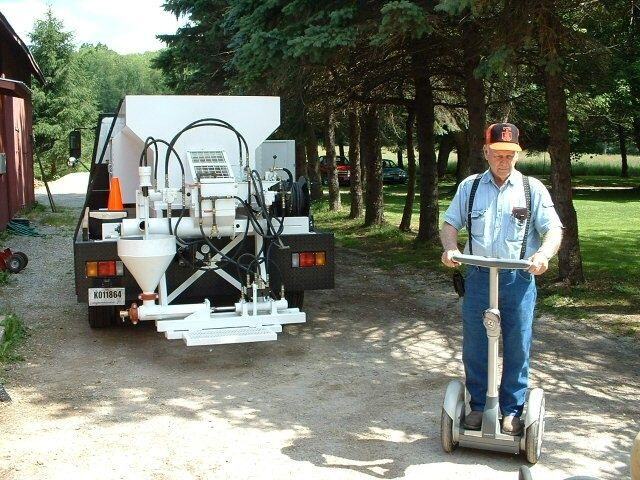
Learn all about concrete leveling’s rich history rooted in innovation.
Concrete leveling has been around since the early 1900s, and throughout the last century, the process has gone through quite a bit of change and development.
In addition to the first concrete leveling method, mudjacking, the concrete leveling industry has expanded to include stone slurry grout and foam.
A-1 Concrete Leveling has been at the forefront of concrete leveling innovation over the past 30+ years, and one of A-1’s founding members, Grover Miller, was at it long before that.
In this article, we’ll be shining some light on the history of concrete leveling, including all three concrete leveling methods we see in use today.
An Overview of the History of Concrete Leveling
Historically, concrete leveling was a labor-intensive and expensive process, primarily used in large-scale commercial projects, like roads and bridges. Mudjacking was the only type of concrete leveling available in the early days.
However, the industry saw a significant transformation in the 1980s when innovator Grover Miller, one of A-1 Concrete Leveling’s founding members, revolutionized the technology and made concrete leveling more affordable and practical for residential use.
Miller’s contributions laid the foundation for the modern concrete leveling industry we see today.

The History of Mudjacking
Mudjacking, often referred to as slabjacking or concrete leveling as a whole, is the oldest method of concrete leveling.
This technique involves drilling holes into the sunken concrete slab and pumping a mixture of water, soil, and sometimes cement beneath the slab to lift it back to an even position.
In the early days, mudjacking was inconvenient and expensive, and the equipment used was not suited for small-scale repairs. The pumping mixture often contained fly ash, a byproduct of coal combustion, which was dirty and hard to work with.
Jim Creed, former president and co-founder of A-1 Concrete Leveling, explains, “Before, the equipment was so cumbersome and labor-intensive. It just wasn't feasible to use on residential properties.”
Nowadays, mudjacking is still around, but mudjacking technicians use smaller, mobile “wagons” to pump the soil mixture below the sunken concrete.
The History of Stone Slurry Grout Leveling
Despite its effectiveness in lifting concrete, the early mudjacking methods weren’t practical for smaller, residential jobs due to their high cost and labor intensity.
Grover Miller’s contribution to the field in the 1980s was pivotal. He refined the concrete leveling process by developing a more portable and efficient pumping system and replacing the dirty fly ash with a cleaner crushed limestone mixture.
Through these developments, Miller pioneered “stone slurry grout concrete leveling,” an alternative to mudjacking. Miller’s mobile pump design significantly reduced labor costs and made concrete leveling a viable option for residential repairs.
Jim Creed explains further, "Grover had a background in construction equipment and was the first one to make [concrete leveling] affordable by downsizing the equipment and making the pump more mobile. So, that was his contribution. He came up with a way to make it affordable to the general population in residential work."
Over the decades since Miller’s initial innovation, A-1 Concrete Leveling has continued to refine the process and increase the amount of control and precision stone slurry grout leveling technicians have when lifting concrete.

The History of Polyurethane Foam Concrete Leveling
The introduction of polyurethane foam in concrete leveling marked another addition to the industry. This method involves injecting a two-part polyurethane foam beneath the sunken slab. As the foam expands, it fills voids and lifts the concrete back to its original position.
Polyurethane foam was introduced for concrete leveling applications starting around 2012, and it has grown in popularity since then.
Some A-1 Concrete Leveling locations offer both stone slurry grout leveling and polyurethane foam leveling services. Each individual repair is unique, so it’s important to use the right material for the specific circumstances of the job at hand.
Related Resource: Polyurethane Foam vs. Stone Slurry Grout Concrete Leveling - Which Is Better?
Concrete Leveling History
The history of concrete leveling is a testament to the power of innovation and the importance of practical solutions to everyday problems. From the cumbersome and dirty early methods of mudjacking to the modern techniques of stone slurry grout and polyurethane foam leveling, the industry has come a long way.
A-1 Concrete Leveling has been at the forefront of this evolution, continually improving and adapting to meet the needs of residential and commercial customers nationwide.
As concrete remains a fundamental part of our infrastructure, the advancements we make in leveling technology ensure that we can maintain safe, functional, and durable concrete for years to come.
Sarah Etler joined A-1 Concrete Leveling after receiving her Bachelor of Arts degree in English from Northern Kentucky University. As A-1's Content Marketing Manager, she works closely with industry experts to produce content that will best answer questions related to concrete repair and maintenance practices. Sarah loves living a life full of discovery and is excited every day to see what new things she can learn and share with those around her.
Topics: